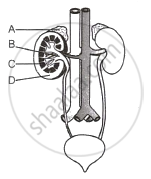Advertisements
Advertisements
Question
Define the following:
Endocrine gland
Solution
Endocrine gland - The glands without ducts which secrete hormones are called endocrine glands.
APPEARS IN
RELATED QUESTIONS
Define Endocrine gland
Describe the T. S. of thyroid gland
Identify the ODD term in each set and name the CATEGORY to which the remaining three belong :
Example : glucose, starch, cellulose, calcium
Odd term : calcium
Category : others are different types of carbohydrates
Addison’s disease, Cushing’s Syndrome, Acromegaly, Leukemia
Choose the correct answer:
Which one of the following is not an endrocine gland?
Place the words at the bottom of the page next to the number that shows the location of the Endocrine Glands.

(1) ________
(2) ________
(3) ________
(4) ________
(5) ________
(6) ________
(7) ________
(8) ________
(9) ________
Pancreas Hypothalamus Pituitary Parathyroid Ovaries Adrenal Thyroid Thymus Testes
Choose the Odd One Out
Column ‘II’ is a list of items related to ideas in Column ‘I’. Match the term in Column ‘II’ with a suitable idea given in Column ‘I’.
| Column A | Column B |
| (i) Pituitary | (a) produces male sex characteristics |
| (ii) Ovaries | (b) decreases blood sugar level |
| (iii) Thyroid | (c) increases heart and breathing rate raises blood pressure |
| (iv) Thymus | (d) produces female sex characteristics |
| (v) Adrenals | (e) is known as emergency hormone |
| (vi) Hypothalamus | (f) regulates the level of calcium and phosphorus |
| (vii) Pancreas | (g) increases the rate of metabolism |
| (viii) Testes | (h) maintains the level of calcium |
| (ix) Parathyroid | regulates the amount of water excreted in the urine. |
| (x) Cretinism | (j) simulates skeletal growth |
| (xi) Diabetes mellitus | (k) regulates the activities of other glands |
| (xii) Insulin shock | (l) stimulates the development of male and female sex organs |
| (xiii) Gigantism | (m) Shortage of glucose in the blood. |
| (xiv) Enlargement of breasts in adult males | (n) Over-secretion of growth hormone |
| (xv) Exophthalmic goiter | (o) Excess of glucose in the blood |
| (xvi) Acromegaly | (p) Over-secretion of thyroxin |
| (xvii) Addison’s disease | (q) Dwarfism and mental retardation |
| (xviii)Cretinism | (r) Over-secretion of cortical hormones |
| (xix) Dwarfism | (s) Under-secretion of the adrenal cortex |
| (xx) Adrenalin | (t) Under-secretion of thyroxin in children |
| (xxi) Vasopressin | (u) Over-secretion of growth hormones in adults |
Select the right match of endocrine gland and their hormone among the options given below
| Column I | Column II |
| A. Pineal | i. Epinephrine |
| B. Thyroid | ii. Melatonin |
| C. Ovary | iii. Estrogen |
| D. Adrenal medulla | iv. Tetraiodothyronine |
Given below is the figure showing the human urinary system with structures labelled A to D. Select the option which correctly identifies them and gives their function.

Distinguish between Diabetes mellitus and Diabetes insipidus (endocrine gland concerned).
